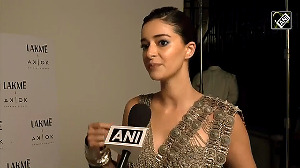The Indian American high school children who were among the 40 finalists in the Intel Science Search competition -- often dubbed the Junior Nobel Prize convention -- may have failed to win any of the top five awards, but they created history and did the community proud.
For a community whose population in the United States is less than one percent, the 10 Indian Americans students among the 40 finalists at Tuesday night’s black-tie gala event at the National Building Museum constituted a 25 percent representation -- the highest ever by any ethnic minority community in the competition’s 72-year-old history.
Last year, with less than five Indian American children among the 40 finalists -- which still was a significant representation -- Indian American Nithin Thume, 17, was the first prize winner of the $100,000 award.
But the best the Indian American children could muster this year was 9th and 10th place, with Akshay Padmanabha, 16, of Houston High School of Collierville, Tennessee and Sahana Vasudevan, also 16, of Gnyanam Academy in Palo Alto, California respectively, winning a $20,000 award each.
Padmanabha developed an algorithm that detected oncoming epileptic seizures and Vasudevan conducted math research that proved a new, generalised way to minimise an important function of arithmetic.
Sara Volz, 17, of Colorado Springs, Colorado, who investigated increasing the oil content of algae to create an economically viable source of biofuel, received the top award of $100,000 in the competition co-sponsored by Intel Foundation and the Society for Science and the Public.
Other finalists from across the United States took home additional awards totaling over $500,000.
The Intel Science Search is the nation’s oldest and most prestigious high school science and math competition. It recognises 40 high school seniors who are leaders in innovation and seeking to solve some of the world’s great challenges.
This year’s finalists hailed from 20 states and represented 40 schools. Of the 1,712 high school seniors to enter the competition, 300 were chosen as semi-finalists in January.
Of these, 40 were chosen as finalists and invited to Washington, DC to compete for the top 10 awards.
They joined the ranks of other notable Science Talent Search alumni who over the past 72 years have gone on to win seven Nobel Prizes, two Field medals, five National Medals of Science, 11 MacArther Foundation Fellowships and even an Academy Award for Best Actress.
Wendy Hawkins, executive director of the Intel Foundation, said, “The Intel Science Talent Search is an opportunity to reshape the dialogue around our nation’s youth.”
“We believe it is crucial to US innovation to bring great attention to math and science achievement, encourage more youth to embrace these fields, and demonstrate the impact these subjects have on our country’s future success,” she said.










 © 2025
© 2025